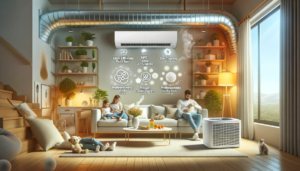Reducing Home Allergens: HVAC Maintenance Tips
 For allergy sufferers, the quality of indoor air is not just about comfort but about health and well-being. Common indoor allergens like dust mites, pollen, pet dander, and mold can trigger uncomfortable and sometimes severe allergic reactions. Fortunately, a well-maintained HVAC system can significantly reduce these irritants and make your home a safer, more comfortable environment. This blog explores practical HVAC maintenance tips aimed at homeowners looking to minimize allergens in their homes.
For allergy sufferers, the quality of indoor air is not just about comfort but about health and well-being. Common indoor allergens like dust mites, pollen, pet dander, and mold can trigger uncomfortable and sometimes severe allergic reactions. Fortunately, a well-maintained HVAC system can significantly reduce these irritants and make your home a safer, more comfortable environment. This blog explores practical HVAC maintenance tips aimed at homeowners looking to minimize allergens in their homes.
Understand the Role of Your HVAC System in Allergen Control
Your home’s Heating, Ventilation, and Air Conditioning (HVAC) system does more than just regulate temperature; it also plays a crucial role in filtering out allergens. The HVAC system circulates air throughout your house, and with the right maintenance and filters, it can remove a significant number of airborne allergens that would otherwise circulate endlessly.
1. Regular Filter Replacement
The simplest yet most effective way to ensure your HVAC system helps reduce allergens is to replace the air filters regularly. Filters trap dust, pollen, pet dander, and other airborne particles. Over time, filters can become clogged, reducing their efficiency and potentially worsening your indoor air quality.
Tip: Use high-efficiency particulate air (HEPA) filters. These filters are capable of trapping 99.97% of particles that are 0.3 microns or larger in diameter, effectively reducing the presence of most allergens. Check and replace your HVAC filters every 30 to 60 days, especially during high usage months.
2. Duct Cleaning and Maintenance
Over time, dust and debris can accumulate in your ductwork, which can then be circulated through your home every time the system runs. Regular duct cleaning can help eliminate this issue.
Tip: Hire a professional service to clean your ducts every 3 to 5 years. Additionally, ensure that there are no leaks in the ductwork. Leaky ducts can pull in additional dust and pollutants from areas like attics, basements, and wall cavities, exacerbating allergy symptoms.
3. Maintain Proper Humidity Levels
Allergens like dust mites and mold thrive in environments with high humidity. Managing the humidity levels in your home can reduce the growth of these allergens.
Tip: Keep your home’s humidity level between 30% and 50%. Use a hygrometer to monitor these levels. Consider integrating a dehumidifier with your HVAC system or use portable dehumidifiers in high-moisture areas like bathrooms and kitchens.
4. Regular Servicing and Maintenance
Regular HVAC maintenance by a professional is crucial not only for the longevity of your system but also for maintaining an allergen-free environment. A well-maintained system runs more efficiently, keeps air clean, and prevents unexpected breakdowns.
Tip: Schedule annual maintenance check-ups with a certified HVAC technician. These check-ups should include inspecting and cleaning the blower, adding lubricant to any moving parts, checking the refrigerant levels, and making sure the system is functioning efficiently overall.
5. Consider Additional Air Purification
In addition to maintaining your HVAC system, consider using additional air purifiers in areas of your home where allergens might be more concentrated.
Tip: Portable air purifiers can be particularly effective in bedrooms or living areas where you spend a lot of time. Look for air purifiers that also use HEPA filters to ensure consistency in filtering out allergens.
Lifestyle Tips to Complement Your HVAC Maintenance
While maintaining your HVAC system is crucial, there are other lifestyle changes and home improvements you can adopt to further reduce allergens:
- Reduce Clutter: Clutter can trap and hold dust and allergens. Regularly cleaning and decluttering your home can prevent allergen accumulation.
- Clean Regularly: Dust and vacuum your home at least once a week using a vacuum cleaner equipped with a HEPA filter. Don’t forget to wash curtains, rugs, and other fabrics where allergens can accumulate.
- Pet Care: Bathe pets regularly to reduce the amount of dander they spread around the house. Consider designating pet-free zones, particularly where allergy sufferers sleep.
- Control Entryways: Use doormats both inside and outside of entry doors and encourage family members to remove shoes upon entering the house. This reduces the amount of pollen and outdoor allergens brought inside.
Conclusion
In conclusion, managing indoor air quality through diligent HVAC maintenance and strategic lifestyle adjustments is a powerful approach for allergy sufferers aiming to enhance their living environments. By incorporating regular system checks, filter replacements, and duct maintenance, homeowners can significantly curtail the circulation of common allergens such as dust, pollen, and pet dander.
Complementing these efforts with additional air purification devices and maintaining optimal humidity levels further fortifies your home against allergen proliferation. Remember, the goal is to create a sanctuary where the air is not just breathable but beneficial, reducing allergy symptoms and promoting overall health.
Moreover, beyond the mechanical upkeep of HVAC systems, personal habits and household routines play an equally critical role. Simple actions like decluttering, maintaining cleanliness, managing pet hygiene, and controlling what comes in through the doors can all have profound impacts on indoor air quality. Each step, no matter how small, contributes to a larger strategy designed to minimize allergens in your home.
By fostering an integrated approach that combines both HVAC maintenance and lifestyle mindfulness, homeowners can ensure their living spaces are not only comfortable but also conducive to better health and wellness for everyone, especially those affected by allergies.

 Jacobs and Rhodes
Jacobs and Rhodes Jacobs and Rhodes
Jacobs and Rhodes